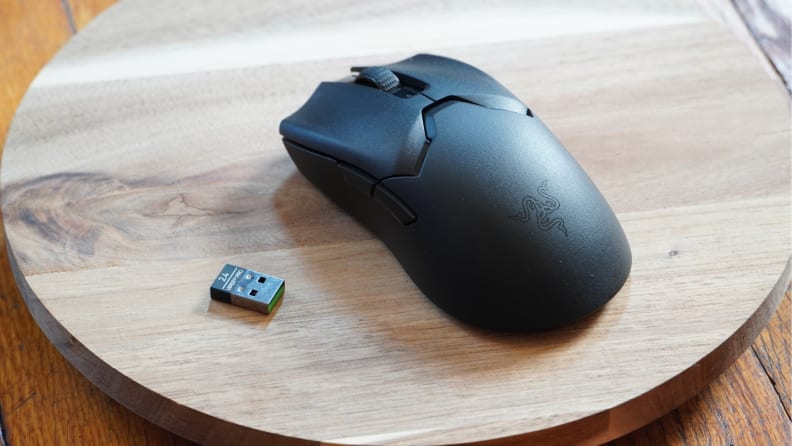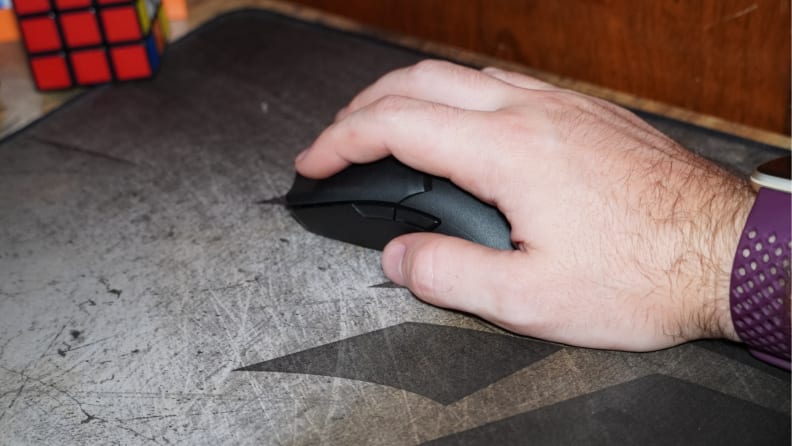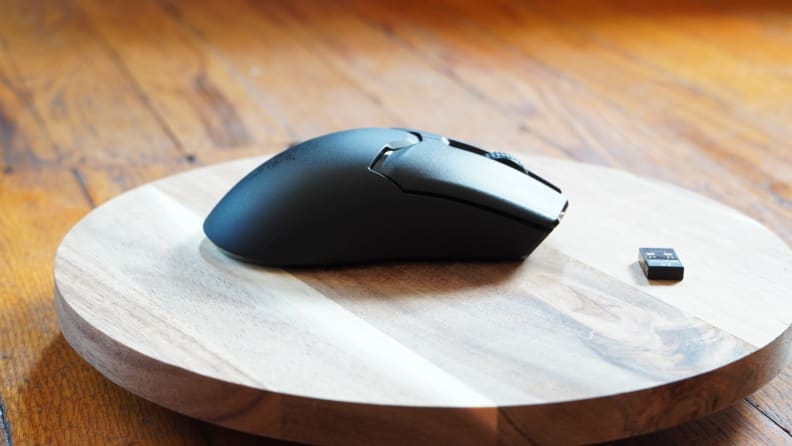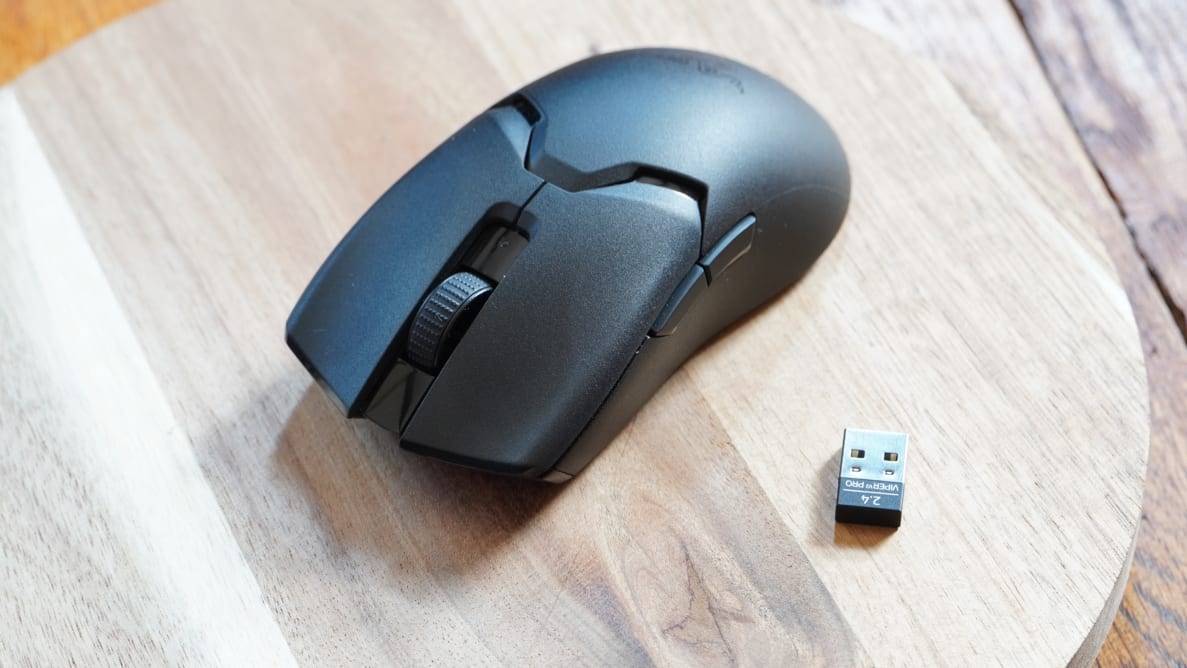Pros
-
High performance
-
Long-lasting battery
-
Extremely light
Cons
-
Tedious DPI switching
-
Limited value for general gamers
-
Not ambidextrous
About the Razer Viper V2 Pro

he Razer Viper V2 Pro is a lightweight mouse with up to a 4,000Hz polling rate, perfect for PC gaming.
- Price: $149.99
- Connectivity: 2.4 GHz HyperSpeed Wireless (USB-A dongle), USB A-to-C cable (included)
- Dimensions: 4.98 x 2.61 x 1.49 inches
- Weight: 58g (2.04 ounces) (white version is 1 gram heavier)
- Colors: Black, white
- Material: Plastic
- Special features: Focus Pro 30,000 DPI sensor, 4,000Hz polling rate (HyperPolling dongle only), 750 IPS max speed, 70G max acceleration, Razer gen-3 optical switches (rated for 90 million clicks)
The Razer Viper Ultimate, Viper 8KHz, and Viper Mini are in the same family as the Viper V2 Pro, but should be treated as different products entirely because of their different switches, sensors, connectivity, and button arrangements.
For instance, the Viper V2 Pro removes the buttons on the right side found on the Viper Ultimate and Viper 8KHz.
Though this mouse is advertised as supporting a 4,000Hz polling rate, the option to do so depends on a separate wireless HyperPolling dongle that can be purchased for an extra $29. The included HyperSpeed Wireless dongle and wired connections only supports the more typical 1,000Hz polling rate.
Razer’s Synapse software isn’t supported on Mac, and that makes it impossible to customize button mapping and sensitivity on the mouse. Without button mapping, the back and forward buttons act as middle-click on Mac. On PC, Synapse allows you to customize keybindings, set up secondary keybinds through Hypershift, adjust the polling rate and lift-off distance, and manage battery settings.

Without rubberized grips and two left-side thumb buttons, Razer was able to craft a mouse that feels almost weightless in your hand.
Unlike many of Razer’s products, the Razer Viper V2 Pro won’t turn heads. There’s no RGB lighting, and snazzy features like an infinitely spinning scroll wheel or wireless charging are missing; this is a sleeper champ.
In the hand, the Viper V2 Pro honestly feels downright cheap because of how light and basic it is. However, it doesn’t feel poorly built.
The construction is entirely plastic. There are no rubberized grips and barely any texture.This may save weight but makes it a little harder to hold onto.
While the ambidextrous shape on Viper models typically include thumb buttons on both sides for righties and lefties, the Viper V2 Pro only includes left-side thumb buttons. All of these trimmings shave the weight down to 58 grams.
That low weight is all to support the high-performance FocusPro 30K Optical Sensor. That’s matched with impeccable tracking that let me consistently land my shots whether I was sneaking my way through Hitman 3, pressuring the opposing team with a consistent hail of bullets in Overwatch, or putting my muscles to the test in a flick shot trainer in the KovaaK’s aim trainer.
Comparing results against the SteelSeries Aerox 5 Wireless I’d been using before, my accuracy in KovaaK’s ‘1wall 6 targets small’ scenario remained within 1% at 88.4 while my overall score dipped from 711 to 671. That’s a deviation small enough to chalk up to hand comfort.
While the lack of RGB may feel like a loss, it delivers a tangible benefit in the 80 hour battery life—though enabling the 4,000Hz polling rate will drop that to just 24 hours.
The tracking is as precise as you’d expect for the price and is matched with consistent, clicky buttons with optical switches. The only annoying button is the DPI toggle, which is on the bottom of the mouse, making it tedious to switch and confirm the settings I want at any given time. The mouse glides with ease on its wide PTFE feet.
Razer also offers the Deathadder V3 Pro, which is nearly identical but bears a right-handed design with a taller arch, providing more comfort for bigger hands at just 5 additional grams.
Should you buy the Razer Viper V2 Pro?

The Razer Viper V2 Pro is functional and well crafted.
Maybe, if wireless esport-level performance is a must
The Razer Viper V2 Pro is an incredibly specialized product, and it almost perfectly does what it sets out to do. It’s ultra light, incredibly responsive, and works without a hitch. The long battery life makes it that much easier to enjoy. Those with larger hands may find it a tad small, but smaller hands will feel right at home.
What was cut to get the weight down will disappoint some users, such as lefties who need thumb buttons or those who like a bit more grip on their mouse. But, Razer has other mice to fill that void, like the Viper Ultimate, which can often be found for under $100. Of course, this kind of high-performance is also offered by wired mice like the Viper 8KHz for a third of the price. Anyone on a budget who just wants a good overall mouse will find many alternatives that do well enough for less than half of the price, like the Corsair Dark Core RGB Pro or Cooler Master MM731.
Despite viable alternatives, the Razer Viper V2 Pro stands out as a powerful, polished tool in the right hands, but most gamers can probably find better value elsewhere.
Meet the tester

Mark Knapp
Contributor
Mark Knapp has covered tech for most of the past decade, keeping readers up to speed on the latest developments and going hands-on with everything from phones and computers to e-bikes and drones to separate the marketing from the reality. Catch him on Twitter at @Techn0Mark or on Reviewed, IGN, TechRadar, T3, PCMag, and Business Insider.
Checking our work.
Our team is here to help you buy the best stuff and love what you own. Our writers, editors, and experts obsess over the products we cover to make sure you're confident and satisfied. Have a different opinion about something we recommend? Email us and we'll compare notes.
Shoot us an email


